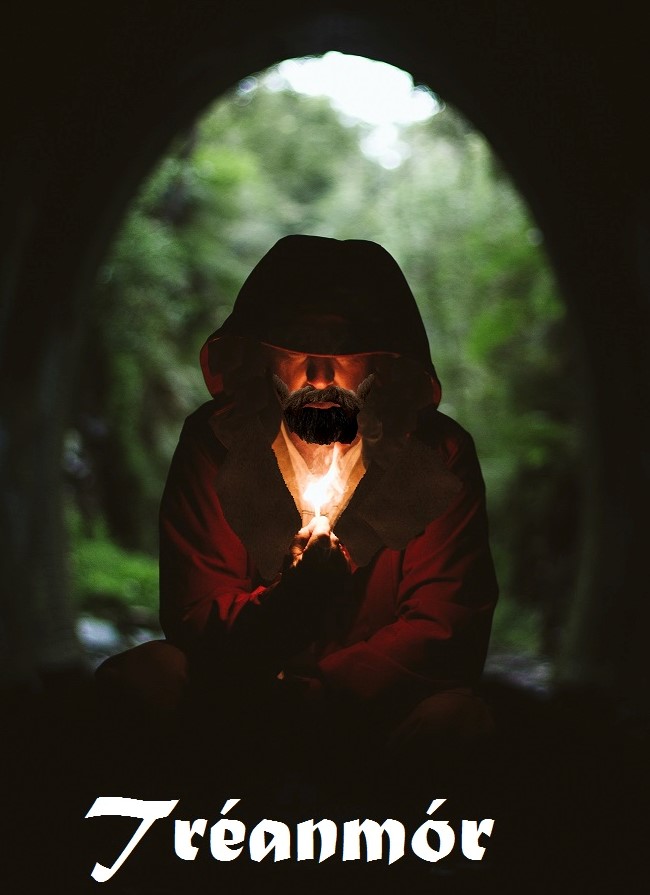
Within the Fenian Cycle, the character of Cumhal (Fionn mac Cumhaill’s father) is sometimes referred to with the interesting patronymic “mac Trénmóir” (or “mac Tréanmór” or in modern Irish) which, literally, means ‘Strong-Big’. This unlikely name is believed to originate from genealogists of the seventh century Leinster families who were keen to link the famous hero to their own ruling dynasties – even if they had to bend the truth to do so.
Apart from those original references, there’s no other mention of Tréanmór within the various historical narratives (which, given its invention, is hardly a surprise). That said, there is a hill called Comaghy Hill in County Monaghan which holds a large grave that’s fancifully claimed to be the spot where he was buried.
This lack of definition around a character who should play an important role in the Cycle (he is Fionn/Demne’s grandfather, after all) provides a lot of room for creative licence and I’ve taken full advantage of that, of course. Over the last twelve months I’ve had a lot of fun creating the character to fit in with the ongoing Fionn mac Cumhaill Series. As a result, for the next book in the series (The Adversary) Tréanmór plays a much larger role than in any other version of the Fenian Cycle in recent times (truth be told, I’ve yet to come across any literary use of the character in the last 100 years!).

Developing the Character of Tréanmór
When developing the character of Tréanmór I was keen to incorporate the world of 2nd century Ireland and link him to some of the issues associated with the tribal society that existed at the time (and which – amazingly – very little literature on Fionn mac Cumhaill refers to). In The Adversary therefore, Tréanmór holds the title of rí – chieftain – of Clann Baoiscne.
Back in the second century, a person’s tribe would not only have played a dominant part in that individual’s personal identity but in his/her entire social interaction as well. Dominant, shrewd, politically astute and completely ruthless, in this particular story, Tréanmór’s driving motivation is the expansion of the Clann Baoiscne tribal powerbase, an objective that’s often attained at the expense of friends and family members. For that reason, although he’s her father, Bodhmhall knows she cannot completely trust him and this becomes clear from the very first reference to him (when Demne – or Fionn – asks about the fortress of Dún Baoiscne:
‘Will we see my grandfather there?’
‘Tréanmór? Yes. As rí of Clann Baoiscne, he rules the stronghold.’
‘Is he nice?’
Bodhmhall blinked, taken aback by the simplicity of the question, the naive reduction of people to those who were ‘nice’ or ‘not nice’.
‘In some ways he is … nice. In other ways, he is not.’
The boy frowned at her. ‘Well,’ he persisted. ‘Do you think he’s nice?’
‘No,’ she admitted. She shook her head. ‘No, I don’t.’
And then of course there’s the little issue of the reason Bodhmhall was expelled from the fortress of Dún Baoiscne in the first place.
In this book, the character of Tréanmór tends to dominate many of the scenes, some of which involve dramatic verbal duelling between himself and Bodhmhall, who also has to contend with his ‘Whispers’ and his ‘Cúig Cairdre’ – his ‘Five Friends’. This has been a lot of fun to write.
This kind of creative licence is one of the things I most enjoy about writing with Irish mythology and lore. The original Fenian Cycle is strong enough and linear enough to provide the basis of the story but it’s also broad enough to allow immense creativity, even when the story needs to align with the historical realities of the period. It really doesn’t get better than that!
The Adversary is expected to be available at the end of February 2017.
Bored? In need of scintillating cultural stimulation?
Then consider our monthly newsletter (below). More in-depth articles on Irish culture (contemporary or historical), mythology/ folklore, occasionally news on new books, writing or other things that amuse us.


